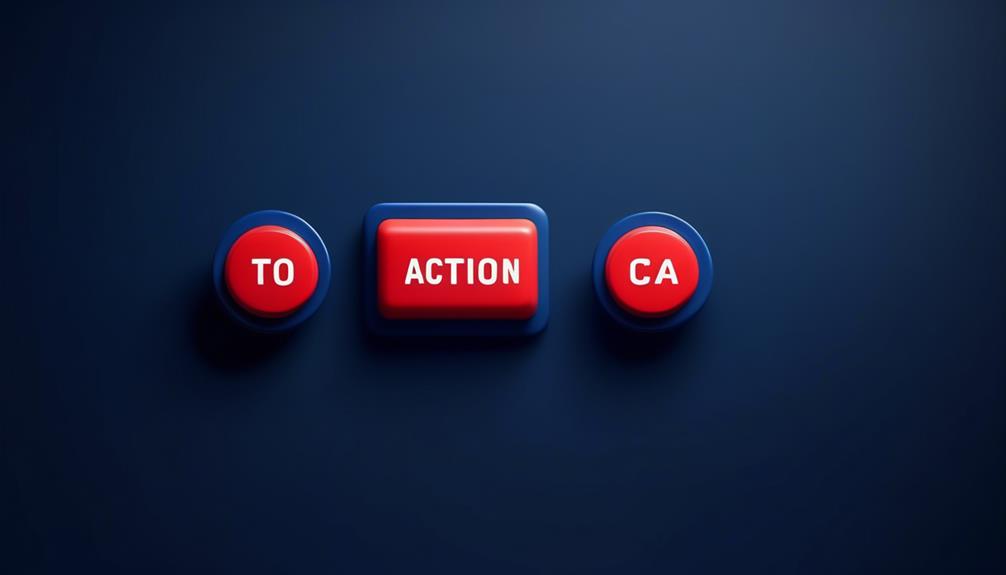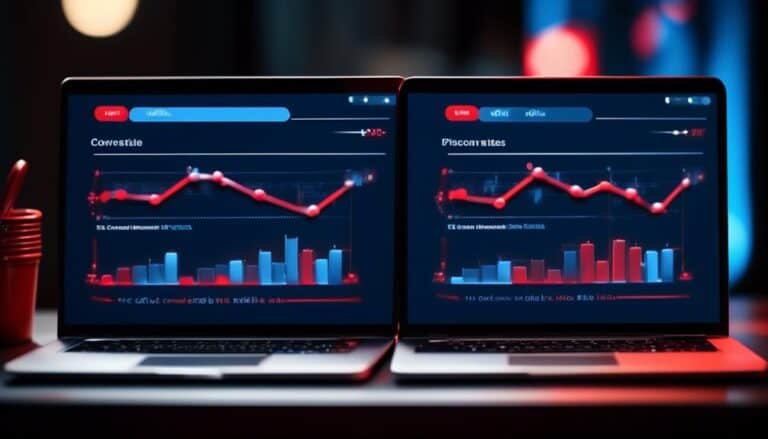Location, Wording, Color: The Triple Threat of CTA Optimization
When it comes to optimizing your Call to Action (CTA), the trifecta of location, wording, and color plays a pivotal role in driving conversions on your website.
The strategic placement of your CTA can either make or break its effectiveness, but that's just the beginning. Crafting compelling copy that resonates with your audience is equally crucial.
However, it's the psychological impact of color that often goes underestimated. So, think about it – where you put it, what it says, and how it looks – all three factors working together to boost your click-through rates and engagement.
Key Takeaways
- Strategic positioning above the fold is crucial for maximizing user engagement and conversions.
- Action-oriented language and addressing audience pain points enhance CTA effectiveness.
- Utilizing contrasting colors and color psychology guides user perception and interaction with CTAs.
- Mobile optimization is essential for ensuring compatibility, responsive design, and user-friendly interactions with CTAs.
Importance of CTA Placement

Effective CTA placement can significantly impact user engagement and conversion rates on your website. Research indicates that strategic CTA positioning can lead to a substantial increase in conversion rates. By analyzing user behavior and implementing data-driven strategies, you can optimize the placement of your CTAs to drive desired actions.
Studies have shown that CTA positioning above the fold tends to generate higher conversion rates compared to CTAs placed lower on the page. Placing CTAs strategically where users are more likely to see and interact with them can result in a more seamless user experience and improved conversion rates. A heatmap analysis of your website can provide valuable insights into where users are focusing their attention, guiding you to make informed decisions about CTA placement.
Innovative approaches to CTA positioning, such as using sticky CTAs or incorporating them within content sections, can further enhance user engagement and conversion rates. By continually testing and optimizing CTA placement based on user interaction data, you can unlock the full potential of your website's conversion funnel.
Crafting Compelling CTA Copy
Crafting compelling CTA copy is crucial for driving user engagement and maximizing conversion rates on your website. By utilizing persuasive messaging and tapping into emotional triggers, you can significantly boost the effectiveness of your call-to-action buttons. To create impactful CTA copy, consider the following strategies:
| Strategy | Description | Example |
|---|---|---|
| Use Action-Oriented Language | Encourage users to take immediate action by using verbs like "Get," "Discover," or "Join." | "Start your free trial now!" |
| Create a Sense of Urgency | Instill a fear of missing out by incorporating phrases like "Limited time offer" or "Act fast." | "Sale ends tomorrow – Shop now!" |
| Address Pain Points | Identify your audience's challenges and offer solutions in your CTA copy. | "Say goodbye to stress – Book now!" |
| Personalize the Message | Tailor your copy to resonate with different audience segments for a more personalized touch. | "Find the perfect match for you." |
| Leverage Social Proof | Use testimonials or statistics to build credibility and trust with your audience. | "Join 10,000 satisfied customers today!" |
Psychological Impact of Color

When it comes to optimizing your call-to-action (CTA), understanding the psychological impact of color is crucial. Colors can evoke specific emotions and influence how your audience perceives your message.
Color and Emotions
Selecting the right colors can significantly impact the emotions and perceptions of your audience. When it comes to color psychology and brand recognition, the choice of hues in your call-to-action (CTA) can make a remarkable difference. Consider the following points to harness the power of color in evoking emotions and driving actions:
- Color Psychology: Understanding the psychological effects of colors can help you choose tones that resonate with your audience's emotions.
- Warm colors like red and orange can evoke feelings of urgency and excitement.
- Cool colors like blue and green are often associated with calmness and trust.
- Bold colors may grab attention, while softer shades can create a more soothing experience.
Color Perception
Harness the psychological impact of color to amplify the emotions and actions your audience associates with your call-to-action (CTA). Color psychology plays a crucial role in shaping how individuals perceive and interact with CTAs. Different colors evoke varied emotional responses, influencing decision-making processes.
By strategically selecting colors based on their psychological effects, you can guide users towards taking desired actions. Moreover, color can be used to establish visual hierarchy within your CTA, directing attention to the most important elements.
Understanding the science behind color perception allows you to optimize the design of your CTAs for maximum impact. Experimenting with color schemes and analyzing their effects on user behavior can lead to innovative approaches in CTA optimization.
Influence of Color
To optimize the effectiveness of your call-to-action (CTA), understanding the psychological impact of color is crucial in influencing user behavior and decision-making processes. When delving into color psychology for your CTA design, consider the following points to enhance user engagement:
- Contrast: Utilize contrasting colors to make your CTA stand out and attract attention effectively.
- Emotional Response: Choose colors that evoke the desired emotional response from your audience, aligning with your brand's message.
- Design Trends: Stay updated on current design trends to ensure your color choices are modern and resonate with your target demographic.
Above the Fold Strategies

When optimizing your call-to-action (CTA) above the fold, consider strategic placement to maximize user engagement and conversion rates. Understanding scroll behavior is crucial here. Users spend a significant amount of time above the fold before deciding whether to continue scrolling. By strategically placing your CTA above the fold, you can capture their attention and drive immediate action. This approach capitalizes on user engagement patterns, increasing the likelihood of conversions.
Analyzing user engagement metrics can further refine your above the fold strategy. By tracking clicks, hover behavior, and time spent on the page, you can gain valuable insights into how users interact with your CTA. This data-driven approach allows for continuous optimization, ensuring that your CTA remains effective in capturing user interest.
Incorporating above the fold strategies based on scroll behavior and user engagement data can significantly impact the success of your CTA. By leveraging these insights, you can create a compelling and optimized above the fold experience that drives conversions and enhances user satisfaction.
A/B Testing Techniques
Utilize A/B testing techniques to iteratively refine your call-to-action (CTA) performance and enhance conversion rates through empirical data analysis and experimentation. A/B testing allows you to make data-informed decisions that can significantly impact your conversion rate and improve user experience.
Here are three key strategies to consider when conducting A/B tests:
- Testing Different CTAs: Experiment with variations in wording, color, size, or placement to determine which combination resonates best with your audience.
- Analyzing User Interaction: Track how users engage with different CTAs to understand their preferences and behaviors, helping you optimize for a seamless user experience.
- Iterative Testing: Continuously test and tweak your CTAs based on the insights gained from previous experiments to achieve incremental improvements in conversion rates and overall user satisfaction.
Mobile-Friendly Considerations

When optimizing your call-to-action (CTA) for mobile users, it's crucial to consider the impact of screen size, button placement, and font legibility.
Screen size can affect how prominently your CTA is displayed, while strategic button placement can enhance user interaction.
Additionally, ensuring that your font is legible on mobile devices is key to maximizing conversions.
Screen Size Impact
Considering the prevalence of varying screen sizes among mobile devices, optimizing CTAs for mobile-friendliness is crucial for maximizing user engagement and conversions. To ensure your CTAs are effective across all devices, consider the following:
- Device Compatibility: Ensure your CTAs are compatible with a wide range of mobile devices for a seamless user experience.
- Responsive Design: Utilize responsive design techniques to adapt your CTAs to different screen sizes, maintaining functionality and visibility.
- Interaction Design: Implement intuitive interaction design to make CTAs easy to locate and interact with on mobile screens, enhancing user engagement.
Button Placement Tips
To optimize button placement for mobile devices effectively, prioritize strategic positioning to enhance user interaction and conversion rates. When considering button size, ensure that it's large enough to be easily tapped on a touchscreen without accidental clicks.
Place buttons where users expect them to be, typically within easy reach of the thumb for one-handed use. Text alignment within the button should be centered or left-aligned for better readability and visual appeal.
Conduct A/B testing to determine the most effective placement for your specific audience and adjust accordingly. Remember, a well-placed button can significantly impact click-through rates and ultimately drive conversions.
Font Legibility on Mobile
Enhancing button placement on mobile devices can significantly impact user interaction and conversion rates, leading to the critical consideration of font legibility on mobile for optimal user experience.
When focusing on font legibility for mobile, consider the following:
- Mobile Readability: Ensure that fonts are easy to read on small screens.
- Use a minimum font size of 16px for body text.
- Choose sans-serif fonts for better legibility.
- Test font colors against various backgrounds for readability.
Call to Action Button Design

When designing your call to action button, prioritize clarity and contrasting colors to enhance visibility and encourage user interaction. Button design plays a crucial role in driving conversion rates. A well-crafted button should stand out on the page, guiding users towards the desired action.
Research indicates that buttons with contrasting colors to the background have higher click-through rates. Utilizing colors that complement each other can draw attention to the button, making it more clickable.
Additionally, consider the size of the button concerning other elements on the page to ensure it's easily accessible and clickable on various devices. A/B testing different button designs can provide valuable insights into what resonates best with your audience.
Utilizing Contrast for Visibility
For optimal user engagement and interaction, prioritize button design that utilizes contrasting colors to enhance visibility and drive conversion rates effectively. When it comes to utilizing contrast for visibility, consider the following:
- Visibility Techniques: Implementing stark contrasts between the button color and the background can significantly increase the visibility of your call-to-action (CTA) buttons.
- Utilize color theory to select colors that are opposite on the color wheel for maximum impact.
- Design Strategy: Incorporating sharp contrasts can guide users' eyes to the CTA, making it the focal point on the page.
- Experiment with different color combinations to find the most attention-grabbing contrast for your specific audience.
- Contrast Optimization: Fine-tuning the contrast levels can lead to a higher click-through rate and ultimately improve conversion rates.
- Conduct A/B testing to determine which contrast ratio works best for your audience and objectives.
Best Practices for CTA Optimization

When optimizing your call-to-action (CTA), it's crucial to consider the impact of its placement and the effectiveness of your copywriting techniques. These two factors, placement, and copy, can significantly influence the conversion rate of your CTA.
Placement Impact
To optimize the effectiveness of your CTAs, strategically placing them within your content can significantly impact user engagement and conversion rates. When considering the placement of your CTAs, keep in mind the following key points:
- Above the Fold: Placing CTAs where users can see them without scrolling can lead to higher visibility and interaction rates.
- In-Line with Content: Integrating CTAs naturally within your content based on user behavior can enhance their relevance and effectiveness.
- At the End of Content: Positioning CTAs at the end of your content can capture users who've shown interest and are more likely to convert.
Copywriting Techniques
Strategically placing your CTAs within your content not only impacts user engagement but also sets the stage for implementing effective copywriting techniques to optimize conversion rates.
Utilizing persuasive language in your CTAs is crucial for driving action. Craft your copy with compelling phrases that evoke emotion and urgency, prompting users to act swiftly. Incorporating power words like 'exclusive,' 'limited time,' or 'act now' can significantly boost your conversion rates.
Additionally, tailoring your copy to resonate with your target audience's pain points and desires can further enhance the effectiveness of your CTAs.
Tracking and Analyzing CTA Performance
Optimizing your call-to-action (CTA) performance requires meticulous tracking and rigorous analysis of user interactions. To enhance your CTA effectiveness, consider the following:
- Conversion Rate Optimization: Monitor the conversion rate of each CTA variant to identify high-performing elements and refine underperforming ones. Analyzing conversion rates provides valuable insights into what resonates with your audience, allowing you to make data-driven optimizations.
- User Engagement Metrics: Track user engagement metrics such as click-through rates, bounce rates, and time on page to gauge the effectiveness of your CTAs. Understanding how users interact with your CTAs can help you tailor your approach to maximize engagement and drive conversions.
- A/B Testing Strategies: Implement A/B testing to experiment with different CTA designs, placements, and wording. By testing various elements and analyzing the results, you can iterate towards more effective CTAs that yield higher conversion rates.
Frequently Asked Questions
How Does User Behavior Differ When It Comes to Interacting With CTAs on Desktop Versus Mobile Devices?
When interacting with CTAs, users on desktops tend to engage more methodically, while mobile users exhibit quicker, more impulsive behaviors. Understanding these nuances is crucial for optimizing user engagement across platforms, especially with a global audience.
Are There Any Specific Cultural Considerations to Keep in Mind When Optimizing CTAs for a Global Audience?
When optimizing CTAs for a global audience, cultural considerations play a crucial role. Localization and understanding language nuances are key factors. Tailoring CTAs to resonate with diverse cultures can significantly impact user engagement and conversion rates.
Can the Use of Animations or Interactive Elements in CTAs Have a Significant Impact on Conversion Rates?
When considering animation impact on conversion rates, interactive elements play a significant role in user behavior. Incorporating engaging features can boost interaction and ultimately drive conversions. Analyzing data on user engagement is key to optimizing CTAs effectively.
How Do Accessibility Guidelines Play a Role in Designing and Optimizing CTAs for All Users?
When optimizing CTAs, accessibility guidelines are crucial for inclusive design. By catering to various needs like user engagement and device preferences, you ensure all users can interact effectively, leading to higher conversion rates.
Are There Any Emerging Trends or Technologies That Are Reshaping the Landscape of CTA Optimization Strategies?
In the ever-evolving landscape of CTA optimization, emerging technologies like AI and machine learning are revolutionizing personalization strategies. By harnessing data-driven insights, companies can tailor CTAs to individual preferences, boosting engagement and conversions.
Conclusion
You've learned the power of optimizing your CTAs through strategic placement, compelling copy, and impactful design. By incorporating the right location, wording, and color, you can drive higher conversion rates and increase engagement with your audience.
Use A/B testing to fine-tune your approach and track performance metrics to continually improve. Remember, the triple threat of CTA optimization is key to maximizing your success in driving action and achieving your goals.








